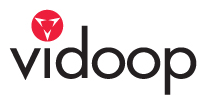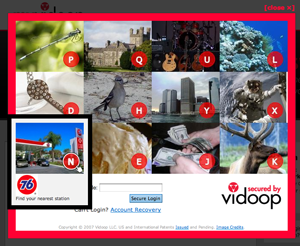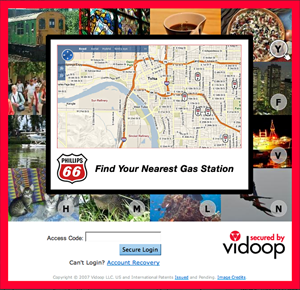A picture is worth a thousand words, especially when those words are passwords you can’t remember. An OpenID startup called Vidoop aims to replace your usernames and passwords with a grid of pictures that may contain visual advertisements. To encourage adoption of its user authentication technology, Vidoop will announce today at the Internet Identity Workshop its intention to pay affiliates, starting January 1st, for the logins to their sites that transpire under the myVidoop service.
MyVidoop serves as both a password keychain for all of the sites you log into across the web, as well as an OpenID account provider. Signing into an OpenID-enabled site with myVidoop, or retrieving all of the passwords in your myVidoop keychain, involves not a username and password, but rather a visual grid of images that fall into particular categories. When you first create a myVidoop account, you pick 3-5 types of images (e.g. birds, skyscrapers, flowers, cars). Then whenever you need to authenticate with myVidoop, you simply type the letters of the images in a randomly generated grid that fall into your chosen categories.
There are two main advantages to using this visual authentication system rather than a tradition username and password scheme. The first is security: because you never need to use a username and password (at least with the “pure” OpenID functionality of myVidoop – the service provides merely a layer for non-OpenID authentications), there’s no way for someone to obtain your credentials and create a robot that hacks into your accounts.
Visual authentication requires that a human – or perhaps (impossibly) smart computer – comprehends the images in a grid and the categories they fall into, plus has knowledge of the categories you have chosen (and are less likely to have written down somewhere). On top of this, myVidoop only lets you authenticate on pre-approved machines so the hacker would need to be sitting at your computer, or have possession of your cell phone to undergo approval, to gain access to your myVidoop account and all its stored passwords.
The second advantage is the potential for generating revenue through advertisements. The images in the login grid can be generic, or they can promote a particular brand or product just like advertisements elsewhere on the web. Vidoop has already signed six partners to advertise through its picture grid (such as ConocoPhillips and SmartUSA, a division of Daimler Benz; you’ll see an ad for the gas station 76 in the screenshot above). Currently, Vidoop sells spots directly to advertisers and the ads are simple image overlays. However, the company is developing an API so that ad networks can channel their content into the grid. Vidoop is also working on interactive overlays with product and service offers that are tailored to users’ locations and preferences (see the map for finding local gas stations below).
The advertising potential of the Vidoop authentication system promises to benefit not only Vidoop but its partner sites as well, which is where today’s announcement comes into play. Starting January 1st, Vidoop will pay partner sites 1/100th of a cent every time someone uses myVidoop to sign into their sites. So, if you are a site owner who has 5,000 logins per day through myVidoop, you’ll get only $15 per month. But if you can persuade 1M of your users to log in with myVidoop every day, you’ll earn $3,000 per month.
Payments will only be doled out when users with OpenID accounts provided by Vidoop sign into your site, not when they simply use myVidoop’s password keychain functionality to authenticate with your proprietary username/password scheme. Nor will you make any money if the user opts for an OpenID account provided by someone else. For these reasons, it’s a bit hard to predict when (or if) the myVidoop revenue-sharing system will ever become attractive enough to yield mass adoption (although sites merely need to allow for OpenID authentication and sign up with Vidoop to begin collecting revenue).
OpenID usage in general will need to reach a critical mass before sites can expect to earn a decent amount of money through Vidoop partnerships. However, the company believes that this critical mass could be around the corner, especially if several of the big players (such as Google, Microsoft, and Yahoo in addition to AOL) begin providing OpenIDs to their users. The push for decentralized social networking through the likes of OpenSocial may require these companies to support a universal authentication system, and OpenID would be a natural choice. Vidoop stands to gain from widespread adoption since increased awareness of OpenID would cause more users to sign up for Vidoop. However, increased awareness would also heighten concerns about the security of universal authentication systems, and consequently make Vidoop’s patent-pending visual authentication scheme more attractive to both users and sites alike.


